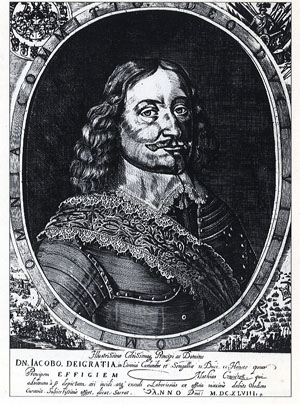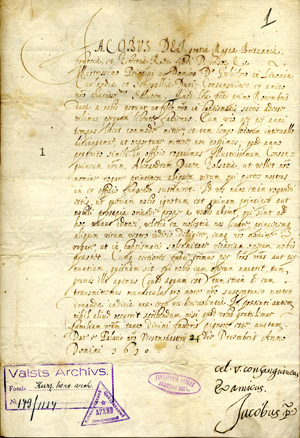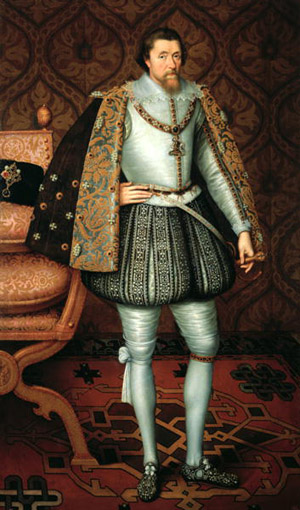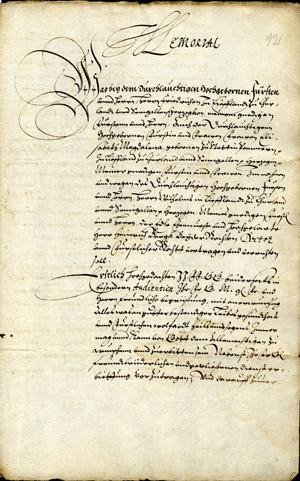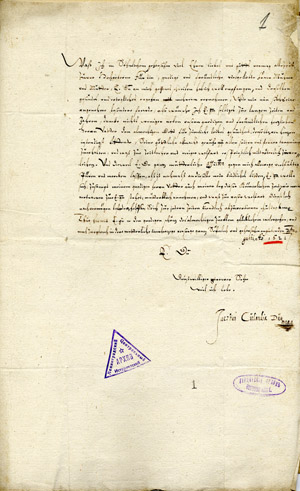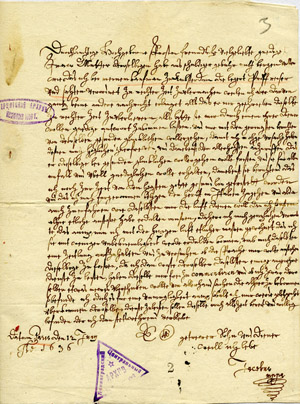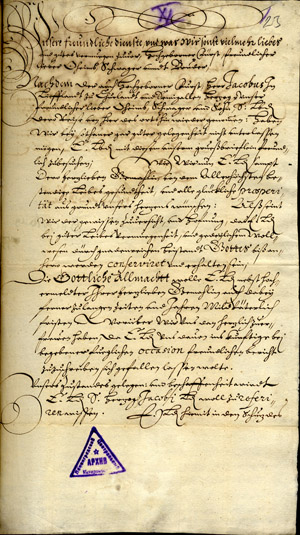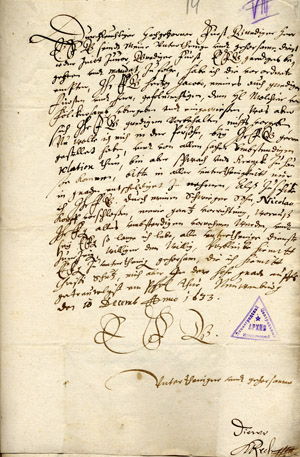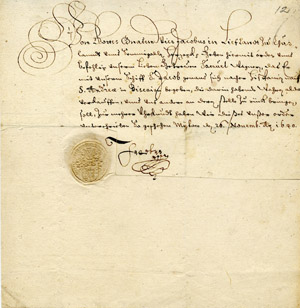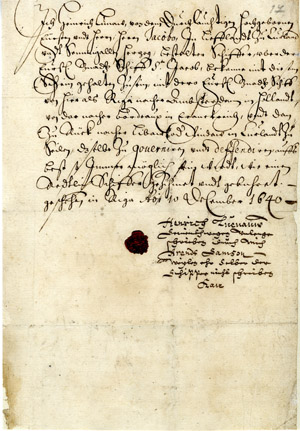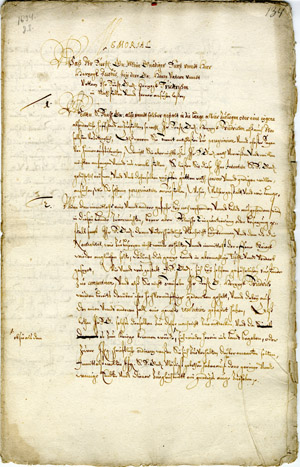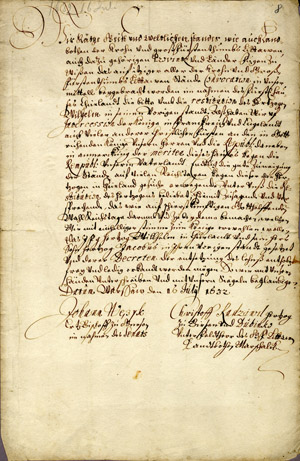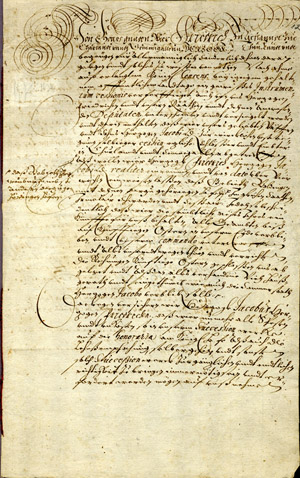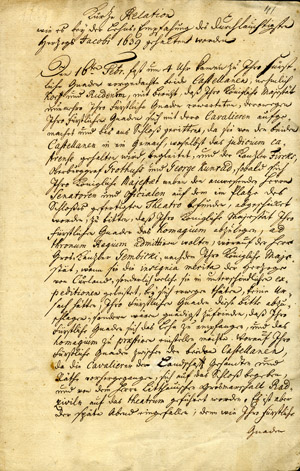Duke James (Jakob, 16101681): the path to the throne
Duke James (Jakob) was born in Goldingen/Kuldīga Castle on 28 October 1610. From the age of two he was brought up by his mother's relatives in Königsberg and Berlin. In 1616, when Duke William was removed from the throne, James also lost his right of succession. As late as 1589, the Sejm of Poland-Lithuania had passed a law that when the Kettler dynasty ended the fief of Courland-Semigallia might by annexed to Lithuania. Thus, restoration of James' right of succession was important both for Duke Frederick, who had no children of his own, and for the knights of the duchy, who in 16161617 had prevailed in their struggle with the dukes and accordingly wished to preserve the duchy in its existing form. The Courlanders had to apply considerable effort in order to restore, if not the rights to the throne of William, then at least James' right to succession. In 1623 Duke Frederick recalled James, who was then studying at the University of Leipzig, to Courland, and in May 1624 the prince was welcomed with ceremony in Goldingen/Kuldīga. The King of Poland finally recognised James as heir to the throne in 1633, but his status was under threat even as late as 1637. However, thanks to Duke Frederick's diplomatic efforts, James could accede to the throne of the duchy after the death of his uncle in 1642.
1. Duke James. Engraving by Mathias Czwiczek. 1648.
2. Letter from James, King of England, to Duke William. Westminster, 24 December 1610. LVVA, Collection 554, Inventory 1, File 88.
In reply to a letter from Duke William on 1 November, the King of England thanks him for the invitation to the christening of his son. The king explains that he cannot be present in person, and so has sent a representative.
3. James Stuart, King of England (15661625).
4. Instruction from Duke William to his councillor Heinrich Berg. Goldingen/ Kuldīga, 2 November 1610. LVVA, Collection 554, Inventory 2, File 2907.
Berg was to invite Duke Frederick and Duchess Elisabeth Magdalena to be the godparents of William's son, born on 28 October, and to arrive for the christening on 16 December. The christening, in the church of Goldingen/Kuldīga Castle, was delayed by a week, because of the death of the child's mother, Duchess Sophie. When the castle fell to ruin, in the first third of the 18th century, the font was transferred to the Church of St Catherine, which gave rise to the story that James had been christened in the town church.
5. Letter from James to Duchess Elisabeth Magdalena, written in his own hand. No place, 2 August 1621. LVVA, Collection 554, Inventory 1, File 218.
This is the earliest known letter from Duke James. The ten-year-old prince expresses his gratitude to the duchess for her concern and wishes her the best of health.
6. Letter from Duke James to Elisabeth Magdalena. Paris, 12 June 1636. LVVA, Collection 554, Inventory 1, File 218.
In the autumn of 1634 James journeyed abroad. After several months in the Netherlands, he arrived in Paris in June 1635. James spent more than a year in France, but it is possible that during this time he also visited England or Spain. In this letter James tells the duchess of his intention to visit Italy in the autumn. James returned to Courland in spring 1637.
7. Duke Boguslaw (Bogislaw) of Stettin-Pomerania (15801637), a friend of Duke William and cousin of Duchess Elisabeth Magdalena.
8. Letter from Duke Boguslaw of Stettin-Pomerania to Duke Friedrich. Alt-Stettin, 30 August 1633. LVVA, Collection 554, Inventory 1, File 90.
In the summer of 1633 James visited his father in Pomerania and also met William's old friend who had given him refuge, Duke Boguslaw XIV. During this visit James received his father's permission to take part in the war fought by Poland-Lithuania against Russia. By joining the campaign in spring 1634 with 300 recruits, James was expressing his gratitude to the King of Poland for recognising his right to the throne. He did not actually take part in the fighting, since peace negotiations were already underway at that time.
9. Letter from Landhofmeister Mathias von der Recke to Duke Frederick. Neuenburg/Jaunpils, 13 December 1633. LVVA, Collection 554, Inventory 1, File 89.
Recke reports that he has handed over the manors of Tuckum/Tukums and the surrounding area to Melchior von Fölckersam, representative of Duke James. In late 1633 Friedrich turned over to James' charge several manors in the part of the duchy formerly ruled by William. In addition to Tuckum/Tukums, he was given the manors of Zabeln/Sabile, Kandau/Kandava, Schtunden/ Skrunda, Luttringen/Lutriņi, Durben/Durbe, Grobin/Grobiņa, Rutzau/ Rucava, Niederbartau/Nīca and Oberbartau/Bārta, along with their districts, as well as the Heiligenaa/Sventāja and Libau/Liepāja Coast bailiwicks.
10. Instruction from James to his servant Samuel Wagner. Mitau/Jelgava, 26 November 1640. LVVA, Collection 554, Inventory 3, File 1949.
Duke James instructs Wagner to take the ship St Jacob to the port of Santander in Spain. There he is to sell the duke's goods and purchase others. The ship may have been built at Windau/Ventspils, where James had established a shipyard in 1639, but there is no firm evidence of this. In February 1641, the St Jacob was wrecked off the coast of Denmark.
11. Assurance by Heinrich Lunauw, captain of the St Jacob, to Duke James. Riga, 10 December 1640. LVVA, Collection 554, Inventory 3, File 1949.
Lunauw confirms that he will sail the St Jacob from Riga to Amsterdam and Bordeaux, and will return to Libau/Liepāja or Windau/Ventspils. He also promises to sail the ship “as a good mariner should”. Since the captain himself was illiterate, the letter is signed on his behalf by Arend Samson, the duke’s factor (commercial agent) in Riga. The document shows that James had changed his earlier decision, and was sending the ship not to Spain, but to Holland and France.
12. Letter from James to Duke Frederick. Annenburg/Emburga, 8 July 1634. Excerpt. LVVA, Collection 1100, Inventory 13, File 719, Volume II.
On his return from the campaign to Russia, James decided to go on a tour abroad, because in his opinion it would be too expensive to maintain two courts. James asks Frederick for advice on where he might travel, how long he might stay, and how he should act in case the truce between Sweden and Poland-Lithuania were not extended and war should break out again.
13. Announcement by the delegates of the Sejm and senators of Poland-Lithuania. Warsaw, 16 July 1632. Copy. LVVA, Collection 554, Inventory 3, File 27.
Sigismund III of Poland, who had for many years been hostile towards Duke William, died in April 1632. The members of the Radziwiłł family, related to the Dukes of Courland, managed to convince the delegates of the Sejm, convened in order to elect the new king, to recognise William's right to the throne of Courland. The announcement states that, on the request of the kings of France and England and other rulers, and in recognition of the merits of the house of the Dukes of Courland, the Sejm and Senate is restoring the previous rights of William and his son James, and promises to achieve the agreement of the new king. Władysław IV, who came to the throne in November 1632, accepted this, with the proviso that William was never to return to Courland.
14. Act of agreement between Duke Frederick and James. Mitau/Jelgava, 19 July 1638. LVVA, Collection 554, Inventory 3, File 27.
In 1637 the brother of the King of Poland put forward a claim to Courland. Then Duke Frederick declared that he was transferring the duchy to James, and also obtained the agreement of the Sejm of Poland-Lithuania, which was opposed to any increase in the king's power. However, under the agreement between the two dukes, Frederick would continue to rule as long as he was able. Meanwhile, James also received possession of manors of Goldingen/Kuldīga, Sahten/Sāti, Irmlau/Irlava, Schwarden/Zvārde, Sessau/Sesava and the harbour of Windau/Ventspils.
15. Account of the investiture ceremony of Duke James. Vilnius, 16 February 1639. LVVA, Collection 554, Inventory 3, File 27.
In Vilnius in February 1639 James received his diploma of investiture from Władysław IV, King of Poland, and in a solemn ceremony in Vilnius Castle gave an oath of allegiance to the king. The description of the ceremony is not particularly detailed, mainly listing the persons present. The ceremony was followed by an official dinner, at which the duke sat between the king and the queen. In Vilnius, James also had to sign a promise to build Catholic churches in Mitau/Jelgava and Goldingen/Kuldīga.
